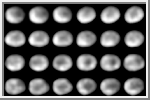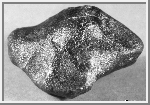















|
The present is the key to the past. -Sir A. Geikie
| Introduction |
|---|
The Hubble Space Telescope observed asteroid Vesta between November 28 and December 1, 1994, when Vesta was at a distance of 251 million kilometers (156 million miles) from Earth. Vesta has a diameter of 525 kilometers (326 miles) and is smaller than the state of Arizona. It rotates about its axis in 5.34 hours.
Vesta is the most geologically diverse of the large asteroids and the only known one with distinctive light and dark areas -- much like the face of our Moon. Hubble images have revealed a diverse world with ancient lava flows and a gigantic impact basin that is so deep, it exposes the asteroid's subsurface, or mantle. Vesta's surface shows a geology similar to that of terrestrial worlds such as Earth and Mars. Ground-based spectroscopy of Vesta indicates regions that are basaltic, which means lava flows once occurred on its surface. This is surprising evidence that the asteroid once had a molten interior, like Earth does. This contradicts conventional ideas that asteroids are essentially cold, rocky fragments left behind from the early days of planetary formation.
One possibility is that Vesta agglomerated from smaller material that includes radioactive debris (such as the the isotope Aluminum-26) that was incorporated into the core. This radioactive "shrapnel" probably came from a nearby supernova explosion. This hot isotope may have melted the core, causing the asteroid to differentiate: heavier, dense material sank to the center while lighter rock rose to the surface. This is a common structure for the terrestrial planets. After Vesta's formation, molten rock flowed onto the asteroid's surface. This happened more than four billion years ago. The surface has remained unchanged since then, except for occasional meteoroid impacts.
One or more large impacts tore away some of the crust, exposing a deeper mantle of olivine which is believed to constitute most of the Earth's mantle. Astronomers believe that some of the pieces knocked off Vesta have fallen to Earth as meteorites, which show a similar spectral fingerprint to Vesta's surface composition.
Vesta offers new clues to the origin of the solar system and the interior makeup of the rocky planets. "Vesta has survived essentially intact since the formation of the planets," Ben Zellner said of Georgia Southern University. "It provides a record of the long and complex evolution of our solar system."
Besides providing scientists with direct samples, Vesta's chipped surface allows Hubble to study the asteroid's rocky mantle, giving scientists a unique opportunity to see what a planet looks like below the crust. "Our knowledge of the interior composition of the other terrestrial worlds, the Moon, Mars, Venus, Mercury and even Earth, depends heavily on theory and inference," Zellner said. "Vesta allows us to actually see the mantle and study pristine samples in our laboratories."
Unlike most other meteorites, this sample can be traced to its parent body, the asteroid Vesta. The meteorite's chemical identity points to Vesta because it has the same unique pyroxene spectral signature. Pyroxine is common in lava flows, meaning that the meteorite was created in an ancient lava flow on Vesta's surface. The structure of the meteorite's mineral grains also indicates it was molten and then cooled. The isotopes (oxygen atoms with varying number of neutrons) in the specimen are unlike the isotopes found for all other rocks of the Earth, Moon and most other meteorites.
The meteorite also has the same pyroxene signature as other small asteroids, recently discovered near Vesta, that are considered chips blasted off Vesta's surface. This debris extends all the way to an escape hatch region in the asteroid belt called the Kirkwood gap. This region is swept free of asteroids because Jupiter's gravitational pull removes material from the main belt and hurls it onto a new orbit that crosses Earth's path around the Sun.
The Australian meteorite probably followed this route to Earth. It was torn off Vesta's surface as part of a larger fragment. Other collisions broke apart the parent fragment and threw pieces toward the Kirkwood gap, and onto a collision course toward Earth. Meteorites found in other locations on Earth are probably from Vesta, too.
| Movies of Vesta |
|---|
| Images of Vesta |
|---|
 Hubble Reveals Huge Crater on the Surface of the Asteroid Vesta
Hubble Reveals Huge Crater on the Surface of the Asteroid Vesta
This picture shows three views of asteroid Vesta. The one on the left is
a NASA Hubble Space Telescope image, taken in
May 1996 when the asteroid was 110 million miles from Earth. The
asymmetry of the asteroid and "nub" and the south pole is suggestive
that it suffered a large impact event. The image was digitally restored
to yield an effective scale of six miles per pixel.
The picture in the center is a color-encoded elevation map of Vesta which clearly shows the giant 285-mile diameter impact basin and "bull's-eye" central peak. The map was constructed from 78 Wide Field Planetary Camera 2 pictures. Surface topography was estimated by noting irregularities along the limb and at the terminator (day/night boundary) where shadows are enhanced by the low Sun angle.
The picture on the right shows a
3-D computer model of the asteroid Vesta synthesized from Hubble
topographic data. The crater's 8-mile high central peak can clearly be
seen near the pole. The surface texture on the model is artificial, and
is not representative of the true brightness variations on the
asteroid. Elevation features have not been exaggerated.
(Credit: B. Zellner, Georgia Southern University; Peter Thomas, Cornell University;
NASA)
 24 Views of Vesta
24 Views of Vesta
This is a NASA Hubble Space Telescope series of 24 images showing the
full 5.34-hour rotation of the 525-kilometer (326-mile) diameter
asteroid Vesta. Hubble resolved features as small as 56 kilometers
(35 miles) across, allowing astronomers to map Vesta's geologically
diverse terrain.
This sequence was taken with Hubble's Wide Field Planetary Camera 2
between November 28 and December 1, 1994, when Vesta was at a distance
of 251 million kilometers (156 million miles)
from Earth.
(Credit: B. Zellner, Georgia Southern University/NASA)
 Topographic Map of Vesta
Topographic Map of Vesta
This is a topographic map of Vesta. It is based upon the shape model of Phil
Stooke. As with all maps, it is the cartographer's interpretation;
not all features are necessarily certain given the limited data
available. This interpretation stretches the data as far as possible.
(Courtesy A. Tayfun Oner)
 Surface Map of Vesta
Surface Map of Vesta
These two maps are derived from images of asteroid 4 Vesta taken between
November 28 and December 1, 1994, by the Hubble Space Telescope. The
mid-latitude region of Vesta, between about 16° south and 48°
north, were favorably situated for viewing from Earth at the time the
images were taken. The map covers a surface area of 518,000 kilometers
(200,000 miles).
The top, surface brightness map shows that, unlike most asteroids, Vesta's surface is significantly varied with a dark hemisphere and a light hemisphere. The surface markings may represent ancient igneous activity such as lava flows and, in addition, regions where major impacts have stripped away the crust revealing mantle material below the crust. The bottom map is a false-color composite showing that all of Vesta's surface is igneous, indicating that either the entire surface was once melted, or lava flowing from its interior once completely covered its surface. It also shows that Vesta has two distinct hemispheres containing two different types of solidified lava basalt.
Current interpretations suggest the red-colored hemisphere has been
heavily excavated by impacts which have exposed the subsurface material.
The yellow-green colored hemisphere might be the remains of Vesta's
ancient crust, formed near the time of the beginning of the solar system.
(Credit: B. Zellner, Georgia Southern University/NASA)
 Vesta Meteorite
Vesta Meteorite
This meteorite is assumed to be a sample of the crust of the asteroid
Vesta, which is only the third solar system object beyond Earth from
which scientists have a laboratory sample (the other extraterrestrial
samples are from Mars and the Moon). The meteorite is unique because
it is made almost entirely of the mineral pyroxene, common in lava
flows. The meteorite's mineral grain structure also indicates it was
once molten, and its oxygen isotopes are unlike oxygen isotopes found
for all other rocks of the Earth and Moon. The meteorite's chemical
identity points to the asteroid Vesta because it has the same unique
spectral signature of the mineral pyroxene.
Most of the identified meteorites from Vesta are in the care of the
Western Australian Museum. This 631 gram (1.4-pound) specimen comes from
the New England Meteoritical Services. It is a complete specimen
measuring 9.6 by 8.1 by 8.7 centimeters (3.7 by 3.1 by 3.4 inches)
showing the fusion crust, evidence of the last stage in its journey to
Earth.
(Photo Credit: R. Kempton, New England Meteoritical Services)